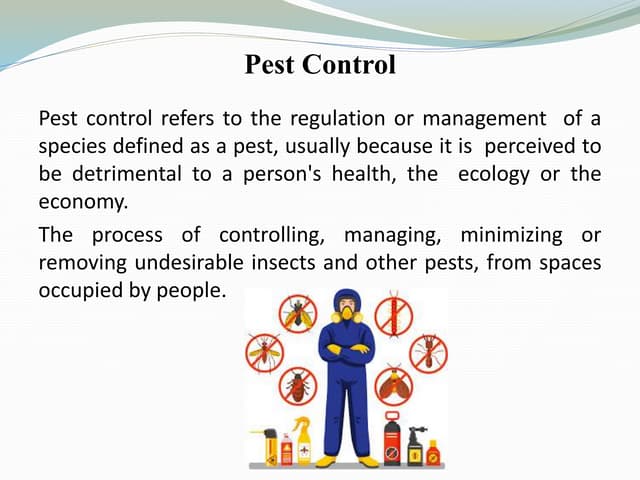The smart Trick of Pestwise That Nobody is Talking About
The smart Trick of Pestwise That Nobody is Talking About
Blog Article
The smart Trick of Pestwise That Nobody is Discussing
Table of ContentsMore About PestwiseThe Ultimate Guide To PestwisePestwise Fundamentals ExplainedAn Unbiased View of PestwiseFascination About PestwiseThe Basic Principles Of Pestwise Our Pestwise Diaries

Q. Define "incorporated bug management" (IPM) and checklist a number of possible control methods that may be used in an IPM approach. A. Integrated bug management is the incorporating of proper insect control techniques right into a solitary plan to minimize insects and their damage to an acceptable degree. Bug control techniques might consist of: host resistance, biological control, cultural control, mechanical control, sanitation, and chemical (pesticide) control.
The 4-Minute Rule for Pestwise
What can you do to maintain the parasites you are attempting to manage from becoming immune to the pesticides you utilize? A. Parasite resistance can be reduced by utilizing integrated bug monitoring and rotating the types of chemicals utilized.
Bugs are a vital hazard to the farming business, and integrated parasite monitoring helps growers address and reduce these dangers. Integrated bug monitoring makes use of several methods in facility, thus being a much more effective solution to the problem. Termite Treatment. Particularly, removing hostile chemical approaches permits reducing damage to people and the atmosphere by utilizing all-natural and much safer choices instead
Our Pestwise Ideas
The goal of incorporated bug administration is to reduce this injury and control acceptable infestation degrees rather than eradicate all unwanted populations. This is why it is vital to comprehend what steps are warranted in each instance and use aggressive ones only when various other integrated management strategies do not work. Integrated monitoring alleviates the unfavorable repercussions of a non-IPM approach, and the main benefits of IPM Advantages of IPM.
An appropriate understanding of the problem range identifies if the trouble must be addressed. are the following components of an IPM program since it is crucial to realize if the microorganisms make possible dangers and determine on the integrated administration options or the certain chemical use. plan to minimize infestations by applying various agronomic strategies.
Little Known Questions About Pestwise.
Integrated administration options in an IPM program start with safer to more aggressive ones. Click This Link The prior incorporated management facets aid recognize exactly how to intend and apply an IPM program action by step: Monitor your crops frequently.

To name a few, IPM social approaches consist of the adhering to area management strategies: dirt therapy; selection of ideal plants; plant turning; interplanting or strip chopping; selection of growing days; weed control; usage of catch plants. Beneficial soil conditions speed up plant growth, and energetic crops are extra immune to problems. Termite Control. In integrated bug monitoring, dirt testing helps understand if the field is ideal for the manufacturing of this or that plant, and afterwards apply the doing not have nutrients to make certain plant healthy growth
9 Simple Techniques For Pestwise
No-till practices aid avoid soil disintegration, adding to lasting farming. When tilling is required, it is advised to conduct it in the loss to subject them to all-natural enemies and serious weather. Healthy plants and seeds predetermine successful crop growth, so it is crucial to select pest-free growing material with solid roots.
Thus, among other applications, crop rotation can be properly used as an integrated bug administration approach. Vermin spread slower if rows of different crop types separate their host plants in intercropping or strip cropping, which is also made use of in the incorporated pest management system. Conversely, invasions boost when plants of the very same plant kind or family members grow together.
Potato beetles can hurt expanding potatoes, in addition to tomatoes. Growing trap plants in patches is one more choice for IPM intercropping. This incorporated bug administration technique suggests drawing in bugs to specific plants and afterwards controlling them with chemical or mechanical strategies. Specifically, you can expand soybeans as trap plants for Japanese beetles.
Facts About Pestwise Uncovered
Obstacles are typical examples of physical IPM approaches. Allow's take a more detailed check out them. Getting rid of or choosing pests out by hand is a time and labor-consuming option that is commonly used in incorporated administration and natural farming. Mature pests or their eggs and larvae are collected by hand and damaged.

Division of Plant Sciences. University of Missouri. Soil solarization is an effective integrated monitoring technique to decontaminate the field by heating it in an all-natural means. This integrated administration approach indicates a common method of damaging pests by predators, parasitoids, microorganisms, and various other organic control agents (also known as antagonistic organisms). The function of organic control in IPM is to.
Getting My Pestwise To Work
With time, their populace turned out to be an actual problem to farmers along with indigenous kangaroos or dingoes. The cane toad is one more situation illustrating integrated organic control failing in this regard when it refused to search the target varieties and became a pest itself. Parasitoids create on or within their hosts to at some point eliminate them after developing.
Report this page